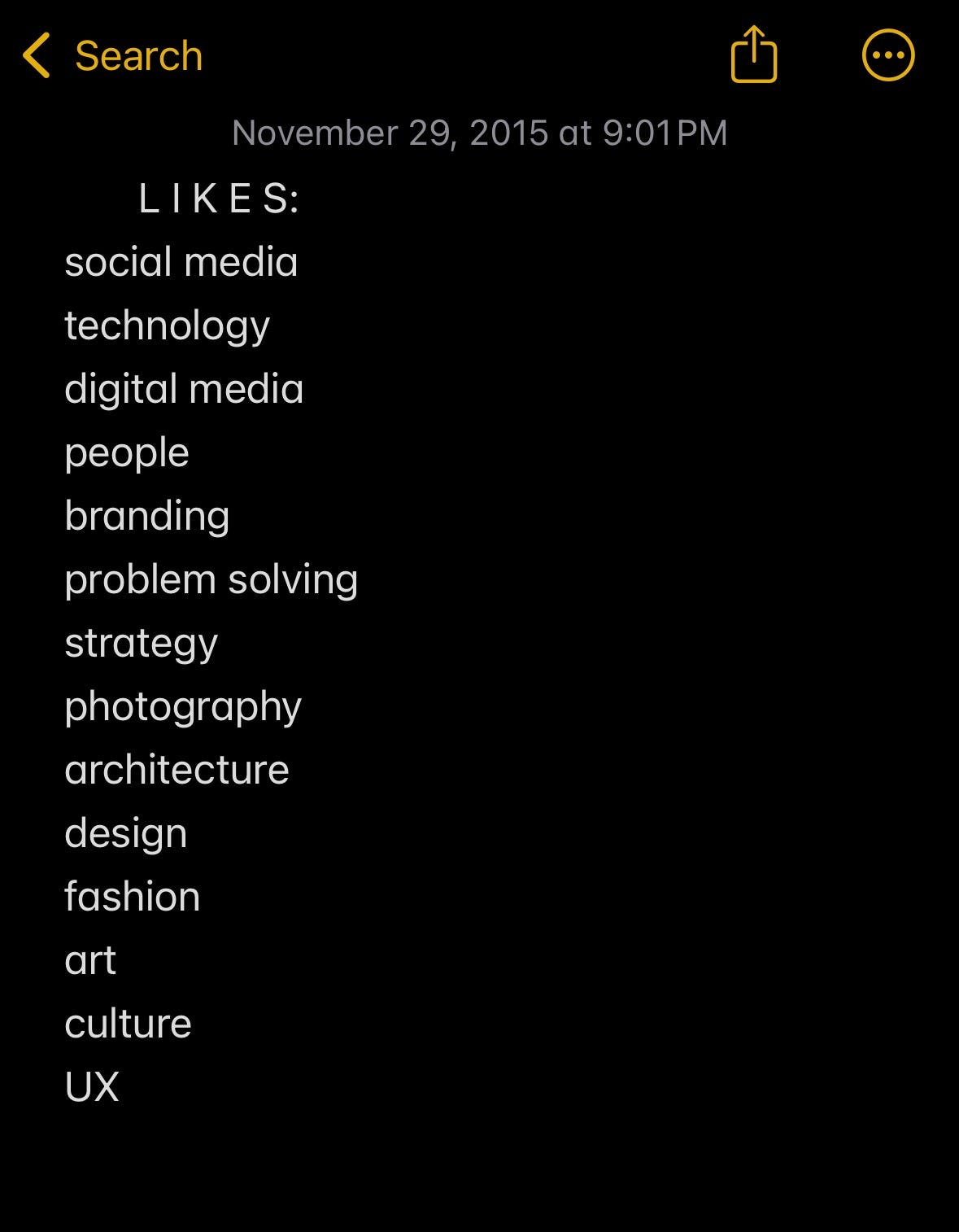Sitting in my apartment in Oakland, not liking my new role even though I had worked so hard to get it — including hustling through the last NSBE convention job fair before graduation with a GPA under 3.0 (iykyk). Still, after a year in, I couldn’t shake the feeling: “Is this it?”
At the same time, being in the Bay Area had lit a fire I’d never felt before. I was surrounded by people who saw no limits; whatever they wanted to do, they believed they could figure it out. That energy was contagious.
One night, I started thinking about what actually interested me. I pulled out my Notes app and made a list of all of my “likes.” It wasn’t a plan, and at the time, it didn’t feel like a pivot. It was just a running list of things that caught my attention: ideas from events I had attended, articles I had read, or topics I’d always been curious about but never had the chance to explore. Most entries were skills or niches. Others were more value-driven, like people and culture.
Back then, it felt random. I was just adding things with no clear direction. Throwing ideas at the wall, hoping something would stick. But looking back, that list was the beginning of my map.
A map doesn’t always start with a destination. Sometimes all you have are points, waiting to connect.
About a year and a half later, after my first layoff, I went back to that list. Eventually, the points started forming patterns. I could see what kept repeating: creativity, collaboration, problem-solving, and creating beautiful things. Even something as simple as writing ‘people’ became a guide. Because as much as I’ve explored different roles and industries since then, community and connection have been the throughline in all of them.
For example, one of the first points I followed was design. I wasn’t a trained designer, but I remembered how my engineering professor told me I was creative, and I had just finished an engineering program that’s basically problem-solving 101. Using that foundation, I started exploring UX, then product work, and eventually narrowed in on web design. What began as a single curiosity grew into projects that became a whole new career lane.
That’s when I realized: the list wasn’t random notes — it was me approaching a new chapter as a sponge. Focusing on what sparked my curiosity, rather than what made sense. Over time, the process revealed itself:
Points → Patterns → Path → Direction
Points - Write everything down, no filters. Every curiosity counts.
Patterns - Zoom out and notice what repeats. The repetition is the signal.
Path - Start with the points that connect to skills you already have, the ones with the least friction. Small wins build momentum, and momentum creates action.
Direction - Clarity comes from moving. The more you follow a thread, the clearer the map becomes.
The mistake most people make is trying to make the map make sense too soon — focusing on the notes instead of moving on them.
What I learned is that the path doesn’t reveal itself upfront; it only becomes clear once you’re already in motion.
So if you created your list today, how would those points shape your map? Which one would you trust enough to take a step toward? Because some maps point to a destination, while others are drawn as you go.
The question is: will you start walking?
Talk soon.
![[K.I.M.] in a Minute](https://substackcdn.com/image/fetch/$s_!KNBS!,w_80,h_80,c_fill,f_auto,q_auto:good,fl_progressive:steep,g_auto/https%3A%2F%2Fsubstack-post-media.s3.amazonaws.com%2Fpublic%2Fimages%2F1a14181a-6233-4a11-b126-ae2f8b245b3f_800x800.png)
![[K.I.M.] in a Minute](https://substackcdn.com/image/fetch/$s_!aEoM!,e_trim:10:white/e_trim:10:transparent/h_72,c_limit,f_auto,q_auto:good,fl_progressive:steep/https%3A%2F%2Fsubstack-post-media.s3.amazonaws.com%2Fpublic%2Fimages%2F8c716011-4ed5-47f0-a14c-9191298c75a2_1512x650.png)


Not me over here singing ‘Boys, we are the boys in motion…’ 🤣 but seriously I loved how you showed that momentum builds through points and patterns. Such a clear framework.